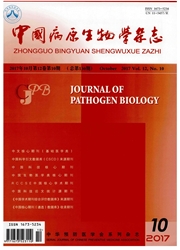

 中文摘要:
中文摘要:
目的通过对实验条件的优化,建立一种高感染率和低死亡率的肺孢子菌感染模型诱导方法。方法以免疫抑制剂诱导大鼠自然感染肺孢子菌为基本方法,对比不同剂量、不同预处理方法、不同季节等因素对诱导大鼠肺孢子菌感染模型的成功率、感染度及动物死亡率等的影响。结果每鼠每次腹膜下注射2.5mg地塞米松(每周两次)至第8周,诱导的肺孢子菌感染率为87.50%,死产率为0,3mg地塞米松组第7周诱导的肺孢子菌感染率为87.50%,死亡率为37.50%,2.0和3.5mg组感染率、死亡率分别为12.50%、0和75.00%、75.00%,差异有统计学意义(P〈0.05);乙醚麻醉组肺孢子菌感染率为100%,非麻醉组为50.00%,差异有统计学意义(P〈0.05);4~6月期间诱导的大鼠肺孢子情感染率为62.50%。7~9月期间诱导的大鼠肺孢子菌感染率为100%,11月~次年1月组感染率为37.50%,差异有统计学意义(P〈0.05)。结论地寒米松腹腔内注射诱导大鼠感染肺孢子菌,以每鼠每次2.5~3mg为最佳剂量;辅助乙醚吸入麻醉可提高肺孢子菌感染率;夏秋季节诱导的大鼠肺孢子菌感染率较高。
 英文摘要:
英文摘要:
Objective To search for a method of inducing Pneumocystis infection to create a model with a high rate of infection and low mortality rate. Methods Rats were naturally infected with Pneumocystis by intraperitoneal injection of an immunosuppressant (dexamethasone). The Factors such as different doses of dexamethasone, use of pre-treatment (inhalation anaesthesia), and different seasons were compared in terms of the rate at which Pneumocystis infection was successfully induced, the level of infection, and the mortality rate. Results Rats that were intraperitoneally injected with 2.5 mg of dexamethasone each time had a rate of infection of 87.50% and a mortality rate of 0% at 8 weeks while rats that were intraperitoneally injected with 3 mg of dexamethasone each time had a rate of infection of 87.50% and a mortality rate of 37.50% at 7 weeks. Rats that were anesthetized with ether had a rate of infection of 100% while rats that were not anesthetized hada rate of infection of 50.00%. The rate of infection with Pneumocystis was 62. 50% during the period from April to June, 100% from July to September, and 37.50% from November to the following January. Conclusion Intraperitoneal injection of 2.5 and 3 mg of dexamethasone is optimal for inducing Pneumocystis infection in a rat model. The rate of infection was higher when rats were anesthetized with ether. The rate of infection increased from the summer to the fall.
 同期刊论文项目
同期刊论文项目
 同项目期刊论文
同项目期刊论文
 期刊信息
期刊信息
